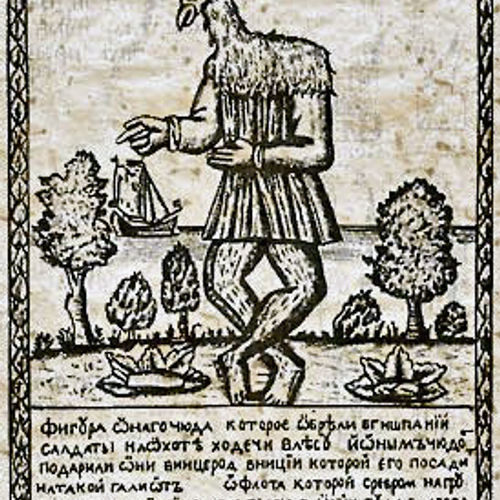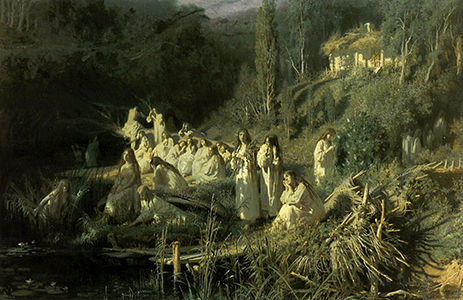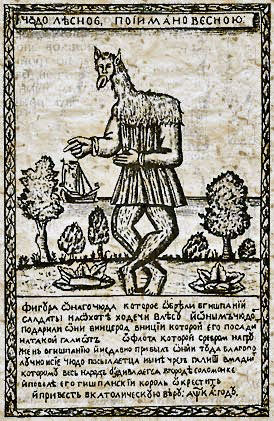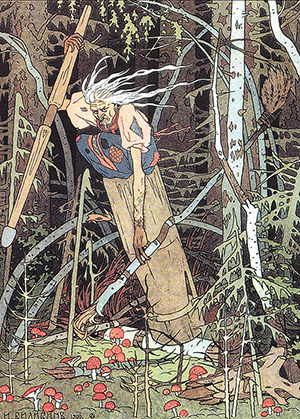
| Added | Fri, 06/01/2017 |
| Источники | Попов. М.И. «Описание древняго славенскаго языческаго баснословия, собраннаго из разных писателей, и снабденнаго примечаниями.»
Зеленин Д.К. «Очерки русской мифологии: умершие неестественной смертью и русалки» – М. Индрик, 1995г.
Леквиевская Е. «Мифы русского народа» – М. Астрель, АСТ, 2000 г.
Афанасьев А.Н. «Мифология древней Руси», Эксмо, 2006г.
Афанасьев А. Н. «Народные русские легенды», 1859
Ироическая песнь о походе на половцовъ удельного князя Новагорода-Северского Игоря Святославича, писанная старинным русским язык
Маш А.Г.. Сокровища Ретры// Пер. с немецкого А.А. Бычкова. - М.: ИЦ «СЛАВА!» -–2006. 352 с., «Древние богослужебные предметы обо
Макаров М.Н. Русские предания. – 1838 г.
Минх А.Н. Народные обычаи, обряды, суеверия и предрассудки крестьян Саратовской губернии. Собраны в 1861–1888 годах. СПб., 1890.
Древнерусские княжеские уставы XI–XV вв.
|
In the study of unexplained facts, the researcher should always know the history of the phenomenon. In search of the origins of a particular legend, our group gathers information from various sources, including the true stories and legends of various places of the planet, trying to look as far as possible in the past.
Place the first circle "on the field" is considered to be Holland, and the birthplace of the legend of the Chupacabra in Puerto Rico. However, this applies to modern ideas about these phenomena, but if you highlight their main features, we can find earlier references to them in other cultures and with a different name that gives a lot of room for analysis.
Below we look at descriptions of some of the beings mentioned in the legends of the ancient Slavs, collected by folklorists during the last few centuries. The vast majority of images are closely connected with the Christian religion, but there are those that are rooted in paganism.
Spirits and creatures from the underworld
The soul of the deceased, the Slavs were represented in the form of a disembodied person, a child, a small person, or small creatures: butterflies, flies, bees, mice, birds, etc. It is the same as in life, could eat, drink, interact with objects and communicate with the living via a dream or reality.
The manifestation of such a connection was considered "communication through an intermediary" when the soul "possessed" in a living person suffering from the same flaws as the deceased. The person through whom you have been interacting, as a rule, was located in the border state of consciousness, and the spirit could say "through it" with others, come to their past friends, family.
Souls may preserve the living and to help them and might harm them. For example, in the annals for 1092 year said:
"Predivno was in Polotsk in the night wailing, down the street, as people, devils prowl, and who get out of the house, wanting to see them, is wounded by demons and die as a result. And did not dare to get out of the houses. And at the same time began to be a day at the horses dead, and could not see themselves, but only the hooves of their horses, and so beating up people in Polotsk and near him what the people said dead beat Polotsk".
It was believed that not only the dead can visit the world of the living, but sometimes live temporarily unable to prove "in that light". This could happen in a dream, in shock or boundary condition of consciousness.
For example:
I became bad then. Sat on the stump, and see, come brother, the late and calls. It's eerie to pick up, and the legs themselves went. Reach a clearing. Bright it was and they all (the dead) and we are walking the walk began. For a long time. Mulberries I say will not go the distance! And he told me – you still early. Look, I'm sitting on a stump.
Ancient Slavs, like many other peoples of the world, distinguished between two kinds of deaths. They were divided by type of death.
The first were people who died a natural death from old age, otiv the measured lifetime. It's the "right" are dead, the people they are called "parents" or "grandparents".
The second species was died an unnatural death, like accident (frozen, burned, drowned), alcoholism, drugs, excessive eating, suicides, and missing persons. To this category were stillborn, mothers ruined or dead unbaptized children. Also "wrong" the dead became witches, wizards, and those who cursed parents. Our ancestors believed that it is of such dead out vampires, mermaids, frights, and various minor demons.
"Wrong," or "salonie" the dead kept the from his death and his grave. Bury them tried at the General cemetery, and in places where they hadn't found his way home (for example at road crossings, creeks, marshes, etc.). The people of these places were considered unclean and dangerous, because there were always evil. When people got to a place he could get off the road, get seriously ill and even die.
It was believed that in places where someone was murdered, the evening and at night are ghosts, but because such places tried not to walk and not ride after sunset. This view exists in the modern world.
Below we consider the types of evil, which, according to Slavic beliefs, manifested himself on earth.
GHOUL
The ghoul is "alive" dead rising from the grave. Mentions of vampires are found in ancient sources since the fourteenth century. Externally, the vampires are virtually indistinguishable from humans, the only difference between them is very sharp teeth. Usually vampires after death become wizards, but the vampire can turn a living person, became the victim of a curse.
These creatures dwell in cemeteries and not far from their graves, but sometimes, in search of food or to escape from pursuers, the vampires can stay in the forest or even in the villages; for there housing they choose dark places where no sunlight penetrates.
At sundown ghouls come out to hunt and eat large animals and sometimes hunt humans. They possess remarkable strength and agility, like an animal overcome any obstacles and leave claw marks. Attacking human, a vampire drank all his blood, and then eats flesh. There is a belief that if the monster will leave the victim drained of blood, but not eaten, it will also turn into a vampire.
Now similar attacks blamed on this mythical creature, like the Chupacabra.
In General, the Eastern Slavic beliefs about vampires in many ways reminiscent of the European beliefs about vampires. Most often, the vampire is in the form of the particular deceased, he is dressed in the same clothes in which he was buried. However, the human form is not mandatory. It could be a demonic image of a half man-half animal, and even species familiar to us living beings, for example, cat or bat.
It is also believed that the walking dead can come back from the grave to their wives. A woman can even get pregnant, but the pregnancy will last the unnatural, for example, is very long and will end in nothing.
MERMAID
Mermaids also become "wrong" the dead, however, consensus about the shape of these creatures there.
I. N. Kramskoy. Mermaid. 1871
wikipedia. Mermaid
In the same way as other salonie dead, mermaids could attack the man and kill him (for example, dismissing or tickle), but for us other interesting superstitions about mermaids:
Dancing is the favorite amusement of the mermaids, where they danced, visible circles and trampled cluster of yellowish grass, and it completely ceases to grow.
This description is strongly reminiscent of the phenomena of witch circles and circles.
DEAD UNBAPTIZED CHILDREN
This category includes a large number of mythological creatures that existed because of the belief that depending on how the children died, they were different demons. For example, in the Russian North believed that the babies, wasted mothers, become icetime – maintenka young men, who like to settle in pools and mills, and presage the misfortune, producing a sound like the flapping of the water by the beach. Of those children who just did not live up to the baptism, obtained Higashi – armless and legless freaks, prokaznitsa at night in the houses.
Now such phenomena associated with the poltergeist.
FRIGHT
It's an evil spirit, sending nightmares to people. For the most part they don't cause serious damage, mainly just throwing a little mischief: that knock something at night, start to creak. But if Fagot disliked some of the family members of leprosy are becoming more serious: the spirit starts breaking the furniture, breaking dishes, harass the livestock, break the yarn, throw things. Sometimes the fright is shown in people's eyes, foreshadowing imminent disaster: if she cries, it will soon be a trouble, but if spinning, soon someone from inhabitants of the house will die. The prediction can be clarified by asking a fright, then she will answer, but only by the clatter.
In the modern world, such phenomena are also associated with the poltergeist, and predictions of misery and knock often attributed to the brownie.
As an illustration, one can cite the bilicki:
In one house, built on the burial place of neoepitope of the deceased, got a fright. Since then the house became quiet: no one in sight, and the human voice groaning, and as I sit at the table, heard a voice: "you Get the hell out of the table!", and don't listen — start throwing pillows. And survived the fright of the owners of the house.
Creatures patrons
For some ideas patrons of various objects, both natural and human-made, as are the souls of the "wrong" of the dead. However, it is now accepted that it is a different mythical characters. About them and will be discussed below.
BROWNIE
This mythological character and to this day is considered the Keeper of the house and everything in it. The house usually rarely is seen, but if he's crossed, knocking on doors, Windows; interferes with sleep at night, uttering terrible sounds, or screams, sometimes even wakes the man, nipping him painfully, and then on the body remain large and painful bruises that the more hurt, the more angry the house; and in extreme cases, the spirit is able to throw dishes, writing bad graffiti and make small fires. Sometimes the spirit living in the house, and mischief for no particular reason. However, serious harm to human house to cause not.
It is interesting that in our time such antics rarely credited with brownie, considering its exceptionally good spirit and guardian of the home. All of the above situation, again, is attributed to poltergeist.
Children and animals can see the house often, he even plays with them. But to hear house can anyone: often it is the unusual knock or incomprehensible grunts. Sometimes the house is howling – it portends trouble in the house. He can also use it at night to pounce on the person, denying that mobility, and, if asked, can predict the future – to answer, "worse to worse." In addition to this, the brownie is credited with the ability to turn into different animals (not necessarily home), and make the appearance of all family members.
In some people's beliefs, there are a number of home spirits, performing their highly specialized work, which in some cases can be identified with the family.
The DEVIL
This is the guardian spirit of the forest. The devil is able to change shape at will to turn into different wild animals, plants and turn around completely to become invisible. Its ability is also included to Eclipse being in the forest people's memories, which they can wander for a long time, lost "in broad daylight", to be snowed visions and even let people into their mystical home, opening the entrance to the underworld.
"Miracle of the forest, caught in the spring". Popular prints of the XVIII century. [2]
But can he help, for example, to get out of the forest or mushrooms.
Now places where you can get lost on a familiar road, to see something unnatural or bad to feel, associated with anomalous and/or geopathic zones.
WATER
Water is neither bad nor good spirit. He owns and protects your pond. It can scare people at night, strange cries can pretend to be a floater or a baby, is able to change its appearance, turning a variety of creatures – fish, animals and even trees. Just like the devil, can "confuse", inducing and enticing depth or in the pool.
In modern performances it is the same anomalous zones, but on the water.
There are a number of similar to the water sprites and mystical creatures – bog, Field, Poludnica, and others. Descriptions of their manifestations are now taking the effects associated with anomalous zones. A particularly interesting Field, which, among other things, privalivaet to the ground the bread and wring the plant. This creature has much in common with the phenomenon of crop circles.
The demi-poludenny
In addition to the wandering souls, did not find solace, and mythical creatures inhabiting the world, the Slavs had ideas about the half human-half. It is not an independent creature, or soul, and it is real people, one way or another received magical knowledge. The Slavs images of half-human half-demon appeared very early – in the proto-Slavic epoch, as evidenced by the related characters in different Slavic mythologies of the late period. It witches, wizards, sorcerers, werewolves, possessed, bewitched. They affect nature, atmospheric phenomena, the harvest, the health of people and animals.
WITCH
The name comes from the verb to know – "know". This character of Slavic mythology is one of the most famous in the modern world.
Ideas about witches have always been very diverse. They could send down a curse on man, bring Wraith for fun or to turn into a creature. But most of the actions of the witches were directed to the enrichment at the expense of neighbors. For example, a witch could take away someone else's crop with the help of the crease (or twist, curls) made from a neighbor's field. Hall and the twist is a bunch of ears, broken at the root, twisted in a knot and pinned ears to the ground or just matted together.
Baba Yaga (the roots of the name go in the Slavonic language. Sometimes translated as witch, witch, forest witch) photo illustration by I. Bilibin, 1900 [5]
Witches were accused that they inflict on field rodents and noxious insects are selected egg laying in chickens, steal yarn from prah and even the stars in the sky; cause hail, floods, fires, storms, plagues. Ancient documents testify that the cause of epidemics and natural disasters almost always seen in the activities of witches and burned women suspected of witchcraft at the stake. In the Charter of Prince Vladimir on the ecclesiastical courts was a separate article, which was tried for "witchcraft and selamicesme" (i.e., preparation of the magic drink made of herbs). In the first half of the XV century during the plague in Pskov burned alive twelve women accused of witchcraft, and during the reign of Tsar Alexei Mikhailovich some Bayou the Reindeer burned in a house together with discovered her arcane securities and roots for the fact that she was ruining people and some were taught witchcraft.
This category can be attributed to sorcerers and healers. They could also cause evil for the benefit and entertainment, but it could, for example, cure from illness. In addition, they turned to various known and unknown creatures.
The WEREWOLF
This is the man that can turn into a wolf (bear). According to legends, the werewolf could become a voluntarily and against their will.
Wizards often turned himself into a wolf to gain power of the beast. It was believed that this sorcerer enough to parechovirus using a tree stump or a couple of knives stuck in the ground tip. Thus, if for a while, until the mage was in the guise of a beast, someone will take out at least one knife from the earth, then the sorcerer will not be able to return to human form.
A person can go into a wolf and after the curse, but in this case, cursed himself is not able to regain human form.
The werewolf possesses immense physical strength, many times superior to the human, as well as impressive speed of movement: during the night the werewolf is able to overcome a few hundred kilometers. For example, in "the Word about Igor's regiment" mentioned Prince Vseslav the werewolf, which at night turned into a wolf and managed in such a way to achieve the middle of nowhere, "the great Horse running wolf way".
The title page of the first edition of "the Word about Igor's regiment"
Other creatures
In the Slavic beliefs, there are a few mythological creatures, the description of which has common features with the contemporary unexplained phenomena. Two of them – Drekavac and Diva – will be discussed below.
DREKAVAC (DREKAVAC)
This half-forgotten creature from the folklore of the South Slavs. His exact description does not exist, some think him an animal, others a bird, and in Central Serbia there is a belief, like drekavac — the soul of a dead person baby. Converge only in one — drekavac knows how terribly scream.
Usually drekavac — hero of children's horror stories, however in remote areas (e.g., mountain Zlatibor in Serbia) in this creature believe even adults. The villagers Tomatina Polje from time to time reported strange attacks on their livestock — the nature of the injury is difficult to establish that it was for the predator. The peasants say that they heard terrible screams, so there is certainly involved drekavac.
The description of this creature has much in common with the modern description of the Chupacabra.
DIV
This is another creature of unknown appearance. Someone thinks its a bird, an animal, and someone describes as a humanoid shadow. Div portends a quick death, or serious distress to those who saw him. A clear description of what it looks like div is missing, as no one who saw not able to recall his image, and diva remembers only as a blurry dark spot in the air. Div has the gift of prophecy, but sees only the troubles and misfortunes that occur. Div can speak human speech in any language of the world.
Description of diva similar to the modern stories about aliens from outer space or a parallel world, is able to predict the trouble an individual or all mankind, to speak in any language (sometimes described as telepathic effects), while often having quite a memorable image.
Conclusion
Comparing the modern legend with historical data, we were able to draw Parallels between known to us anomalous phenomena and what was believed by the ancient Slavs. Indeed, descriptions of occasions in the old texts and the stories of contemporary witnesses of anomalous phenomena similar in many ways.
In ancient times people tried to explain the usual for us, but strange events with the help of divine or mystical creatures. Now we understand this because we know the scientific explanation for these phenomena. But the greatest interest to us are the cases depicted in the old the true stories that have not yet found explanations and resonate with contemporary eyewitness accounts of anomalous phenomena.
It is obvious that many of the creatures which are trying to explain some of the phenomena were known to the ancient Slavs, albeit under names different from the current one. The people of the XXI century have ceased to believe in hobgoblins and devils, and began to believe in poltergeists and the Chupacabra, but the name change does not make these beings more real than they were in ancient times.
As you know, used names and terms change their attitude to them to describe the facts. If the story about the incident flashes the name "ghoul" (or "drekavac", "werewolf", ie the name of any mystical creatures attacking livestock or people, sucking blood, or were particularly brutal, not human or known animal), then it will change the attitude of the narrator, and it will cease to be taken seriously. However, if the witness in describing the occurrence, speaks of "the creature", the listener may be attentive, because "you never know still unexplored beings." Thus the essence of the description remains the same.
On this basis, we can recommend the analysis of the facts to rely not on the name of creatures and phenomena, which they say witnesses and a description of their inherent characteristics.
Translated by «Yandex.Translator»
Log in or register to post comments




